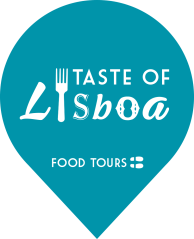10 Christmas Foods You Must Eat in Portugal
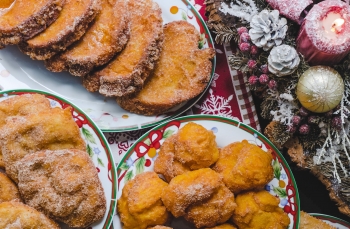
Whether you are a part of a traditional family that will care to go to mass on Christmas Eve, or a more contemporary group of people where family and friends mingle on this special date, you can be rest assured that food will be a constant in any festivity, even more so Christmas, one of the most celebrated holidays all over our country.
So, what do the Portuguese eat during Christmas? This is one of those occasions when we actually keep it fairly simple when it comes to main meals. But when dessert time comes around, we go all in! The Christmas array of sweets in Portugal is truly something to behold. But after your eyes glow in excitement, it’s time to dig in!
Portuguese food culture is not just about eating. It’s it also about slow cooking, spending time around the table, socializing while sipping some wine, while sitting down or even before meal times, right at the kitchen. This means meals can take several hours filled with eating, drinking and laughing away.
In Portugal, it’s not unheard of to finish a meal, lounge around the table discussing current and past affairs, until you get the munchies all over again. That’s why having big spreads over Christmas, when you normally get to see more people than in other regular family gatherings, comes in handy. So much catching up to do… so many treats to try on the same day!
If you are spending Christmas time in Portugal, here are 10 foods you must try:
1. Bacalhau com Todos – Codfish with all

In Portuguese, Christmas Eve Dinner is called Consoada. The star dish of one of the most important dinners of the year in Portugal could be none other than our much beloved salted codfish. For Christmas, it is customary to enjoy a fairly simple dish of cod fillets, with boiled sides such as potatoes, carrots, greens, and eggs, drizzled with a generous amount of olive oil.
The tradition of eating bacalhau on Christmas Eve has to do with the fact that, following Catholicism, the day before Christmas was a time when religious followers were supposed to abstain from eating meat. In a country where vegetarianism wasn’t really a concept, not eating meat would be synonymous of preparing fish based dishes. Before refrigeration and the days of quick transportation, cured cod meant easier access to fish for everyone in the country, including those living in mountainous areas far from the coast.
What initially started as something done out of necessity, eventually became a tradition. Nowadays, it would be rare to find a Portuguese person, in Portugal or abroad, who doesn’t love codfish. It is a food that is highly linked to Portuguese identity and, as such, it makes perfect sense that one of the main feasts of the year includes the fish that we here in Portugal refer to as ‘the loyal friend’.
If the Portuguese Christmas dining experience would end right here, one could almost think we’d got robbed of the extravagance that this type of festivity normally involves. But considering the rest of the things that end up making an appearance on the table, you can be rest reassured that this is certainly not the case!
2. Octopus
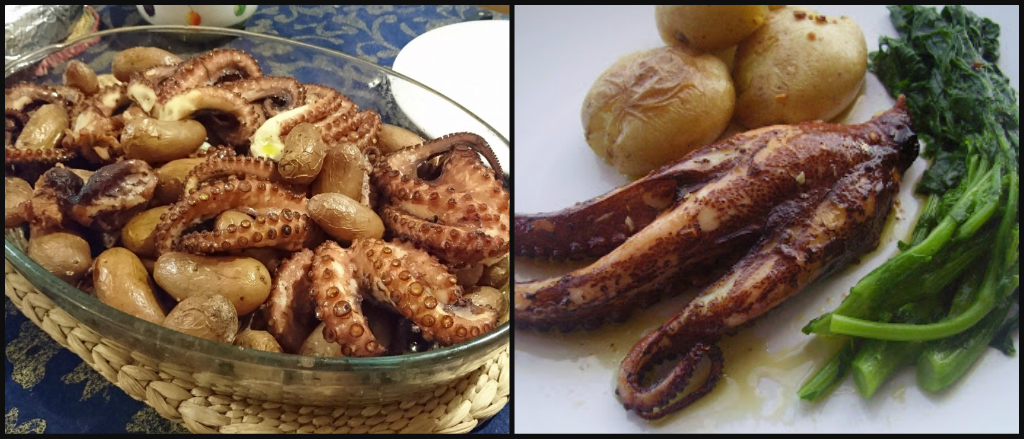
While codfish will be present in Christmas tables all around Portugal, other savory dishes may vary according to region. In the northern regions of Minho, Douro and Trás-os-Montes, it is very common to include octopus. The tentacles will be boiled until soft, and served with the main dish of cod and vegetables. Always drenched in olive oil, that is sometimes previously heated with garlic cloves for extra flavor.
3. Roupa Velha
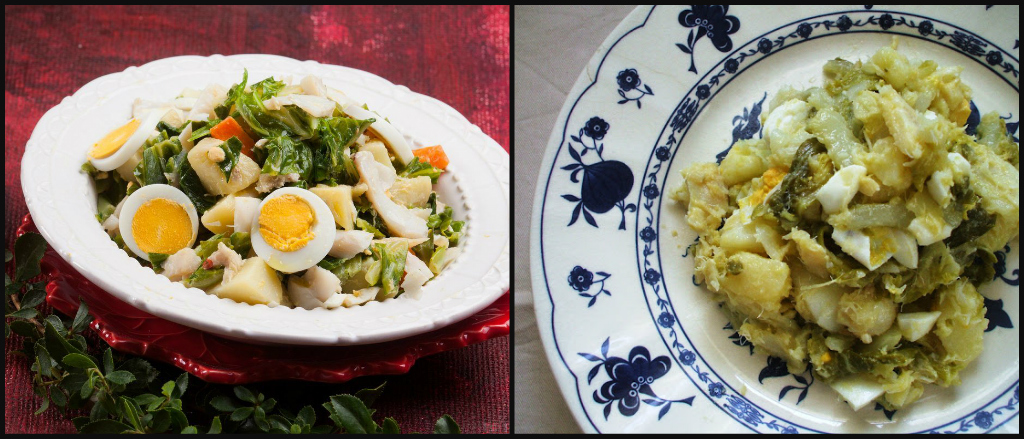
This is not a dish family would enjoy on Christmas Eve’s dinner, but during Christmas lunch. Folks into sustainability and zero waste would love to know that, among other treats, Portuguese Christmas lunch includes a preparation that translates as “old clothes”. It basically consists of seizing the ingredients leftover from dinner on the previous night. We are talking about shredded codfish and chunks of potatoes, greens and other veggies that are stir-fried with olive oil and garlic. Not only we are not letting anything go to waste, we actually end up with a delicious and comforting brand new dish! Besides Roupa Velha, roasted meats such as turkey, lamb and goatling are also common during Christmas lunch.
4. Bolo Rei and Bolo Rainha

You know the Christmas season is approaching when pastelarias, local pastry shops, start piling up colorful Bolo Rei in their display counters. ‘King Cake’ may be the most Portuguese of all Portuguese Christmas sweets, but it’s actually an adaptation of French Gâteau des Rois. Back in 1829, the oldest and still running pastry shop in Lisbon, which we visit during our Lisbon Roots, Food & Cultural Walk, introduced this dessert to Portugal.
Bolo Rei, whose name refers to the Three Wise Men in its name, is eaten in Portugal between Christmas and the Epiphany, 6th of January, which is in Portugal called King’s Day. This crown-shaped cake consists of a dough similar to brioche, enriched with plenty of dried fruits and topped with eye-catching crystallized fruit cuts. As not everyone is fond of this ultra sweet and gooey fruits, Bolo Rainha is also commercialized. ‘Queen’s Cake’ consists of the same recipe, forsaking the candied fruit. Younger generations tend to prefer Bolo Rainha.
Traditionally, Bolo Rei would also include a fava bean and whoever ended up with the dried bean in their piece of cake, was meant to buy the following year’s cake for the family. Back in the day, a golden coin, small metal toys, of Jesus or with other religious motifs, would also be included. Contrasting with the ‘punishment’ of those who’d get the fava bean, finding this coin or figurine would be a gift, but for safety reasons this practice has been discontinued. Prize or not, one thing is for sure: Bolo Rei is a sweet staple of the Portuguese Christmas table. Eaten fresh on Christmas, or a few days later, sliced, toasted and slathered with butter, Bolo Rei a cake almost everyone in the country will indulge in at least once around Christmas. If nothing else, for the sake of tradition!
5. Rabanadas
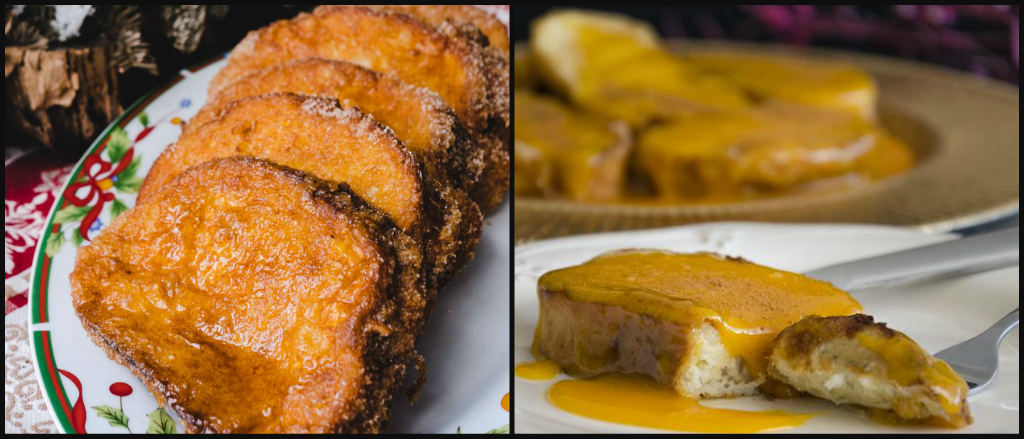
Reducing Portuguese Christmas sweets to just a handful of preparations will always be unfair, as the array of sweets we eat during the holiday season is incredible! Most Portuguese Christmas desserts consist of some variation of fried dough, sweetened either with granulated sugar and cinnamon, or home-made syrup. Rabanadas are Portugal’s take on French toast and they are also known as Fatias Douradas, that is, golden slices.
During December and early January, bakeries will sell cacete, a specific type of bread used to make this preparation and that is hard to come by during the rest of the year. This harder drier bread is ideal to soak up a sweet mixture of milk and eggs, that once it’s been fried, will turn an otherwise humble slice of bread into one of Portugal’s favorite Christmas snacks. Rabanadas are good for dessert, breakfast or anytime of the day, really. Unlike French toast, they are normally prepared in advance, and consumed room temperature whenever you feel like something sweet.
Variations of Rabanadas include Rabanadas com Doce de Ovo, good ‘ol Rabanadas with a top layer of thick egg jam, and Rabanadas com Vinho do Porto, where the traditional milky mixture used to soak the bread is substituted by water and Port Wine – it doesn’t get much more Portuguese than this!
6. Sonhos
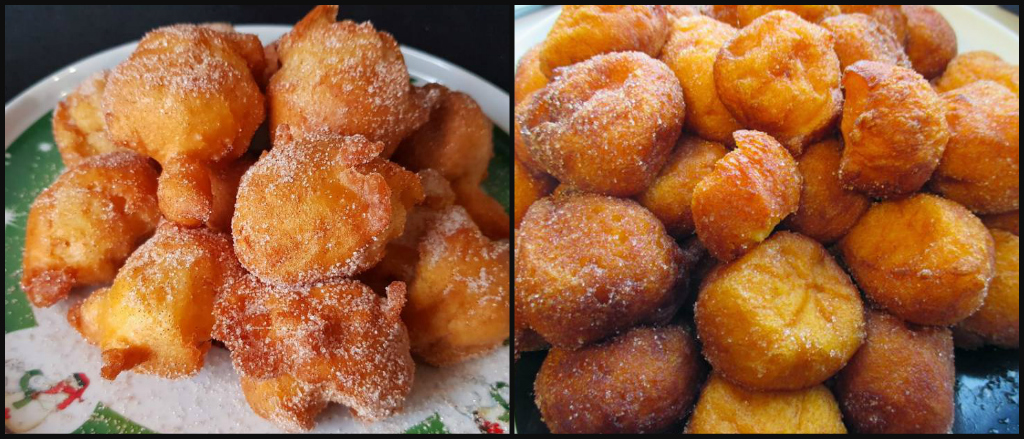
In the extensive list of Portuguese Christmas sweets, Sonhos are a dream come true. Literally! As this is what Sonhos translates as – dreams! These are the fluffiest doughnuts you can think of. These ultra airy fritters come in a few different flavors. While some confectioners will these days play around with different tastes and colorings, traditional Sonhos tend to come in two main varieties.
The default ones would be the plain ones, fried until slightly crispy on the outside but impossibly fluffy on the inside, served dusted with sugar and cinnamon. The main variety on this recipe would be Sonhos de Abóbora, with pumpkin. Thanks to the addition of pumpkin flesh to the batter, these fritters would be denser than the plain ones, and acquire a caramelized texture while frying. All Sonhos, plain, pumpkin or otherwise, may be also served with syrup or honey, for an extra luscious flavor and irresistible texture.
7. Filhós
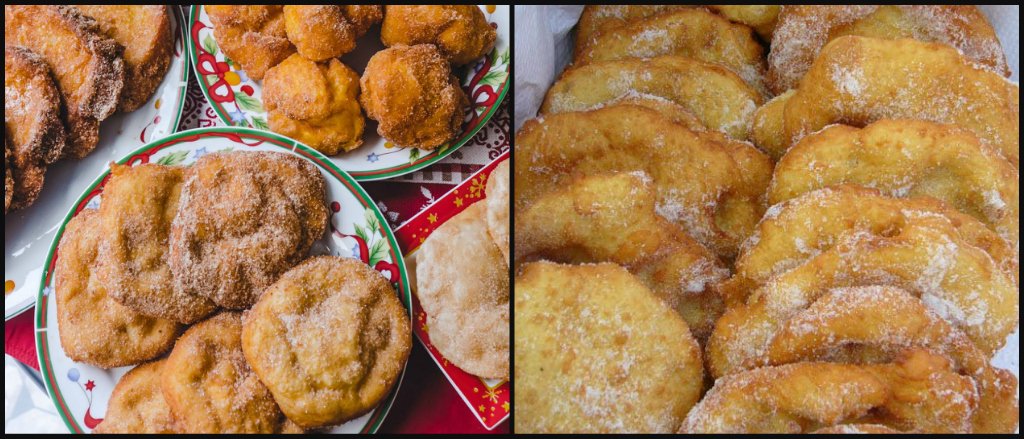
Similar to Sonhos, Filhós or Filhoses also consist of a type of doughnut, that is, fried sweet dough coated with sugar and cinnamon. In this case, they are made by stretching out the risen dough which is cut into larger and flatter portions than those used for round Sonhos. These golden fried treats are common in countries all over the world where the Portuguese have had a historical impact. In North America, Filhós will often be referred to as Malassadas, thanks to the influence of immigrants from Madeira islands. Just like Sonhos, these Christmas fritters may come in different flavors, being pumpkin the most common of them all.
8. Aletria
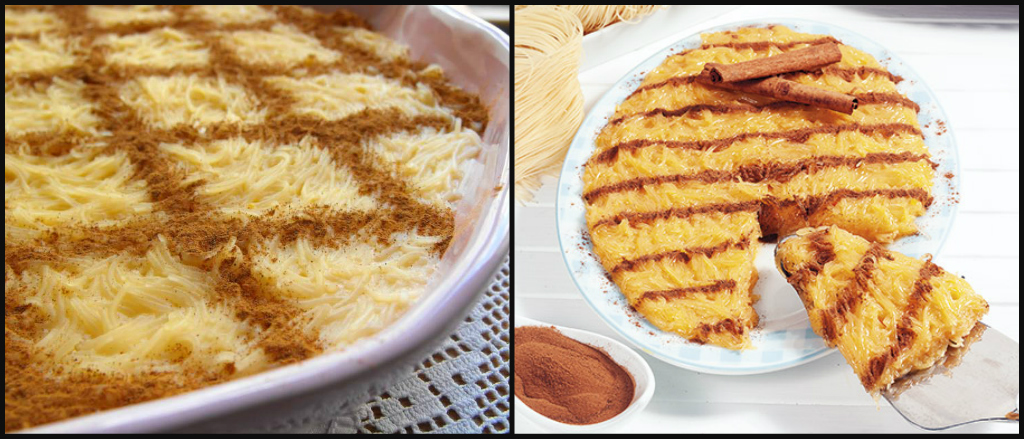
Aletria speaks out loud about the influence the Moorish people from the north of Africa have had in Portugal. This dairy pudding that takes its Portuguese name from iṭriyah, the Arabic word for thin angel hair noodles, is usually prepared in big batches and thus is perfect for large family gatherings. Aletria can be consumed lukewarm or room temperature. Depending on the recipe or part of the country, it may be creamy and somehow runny, eaten with a spoon, or hard enough to be cut into portions. Milky, buttery, with a subtle hint of lemon, Aletria is traditionally served in large trays, decorated with patterns of powdered cinnamon.
9. Azevias
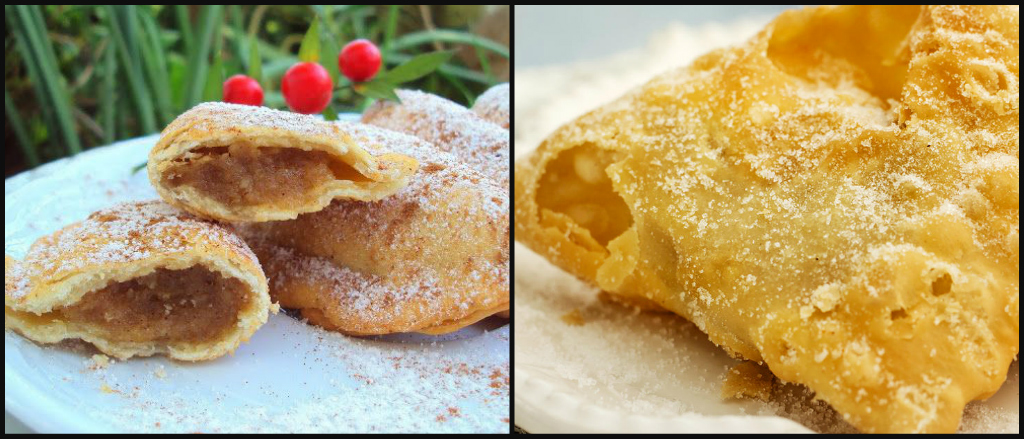
These turnovers include one of the most surprising fillings of Portuguese Christmas Sweets. Inside crispy fried dough, hides a thick stuffing made with pureed chickpeas and ground almonds. This combination is not too sweet and highly satisfying! Variations of Azevias may include alternative fillings of pumpkin or sweet potato, but following ancient Christmas traditions of Portugal’s ever present sweet tooth, will always be finished with an indulgent coating of sugar and cinnamon.
10. Lampreia de Natal
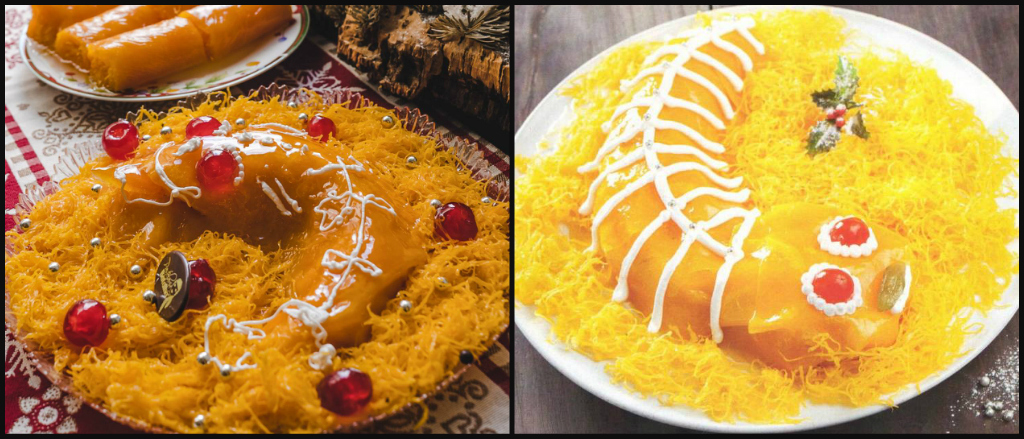
Because this wouldn’t be Portugal if we didn’t include any egg yolk heavy desserts on the table, behold Lampreia de Natal. Also known as Lampreia de Ovos, this dessert’s name translates as Christmas’ Lamprey. Thankfully, no flesh is involved in this sugar and egg yolk loaded preparation, which is served resembling the shape of the snake-looking bloodsucking river fish which, turns out, is also a delicacy in Portugal. To make Lampreia de Ovos, besides sugar and eggs, almonds are used to give shape to the sweetest monster you will come across on the typical Portuguese Christmas table.
Considering that these are some of the most essential foods you can indulge in during Christmas time in Lisbon and the rest of Portugal, we can only hope you ask Santa for some loose pants! Enjoy and Happy Holidays! Or, as we say in Portuguese, Boas Festas!
Keep feeding your curiosity on Portuguese food culture:
Set the table – Portuguese essentials
Real people, real food. Come with us to where the locals go.
Join us in our natively curated food & cultural experiences.
Follow us for more at Instagram, Twitter and Youtube
